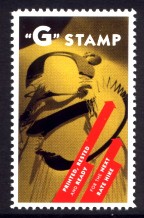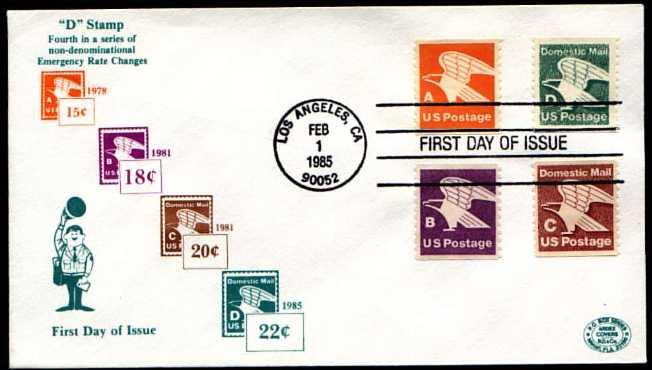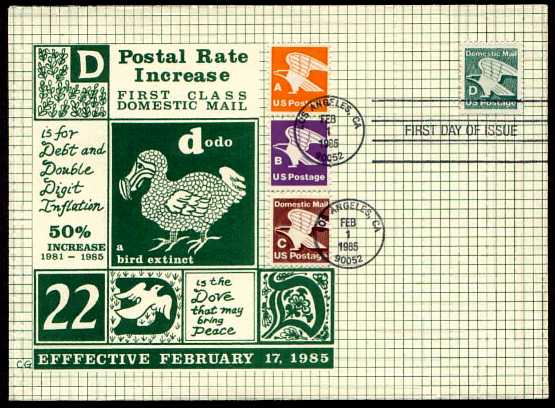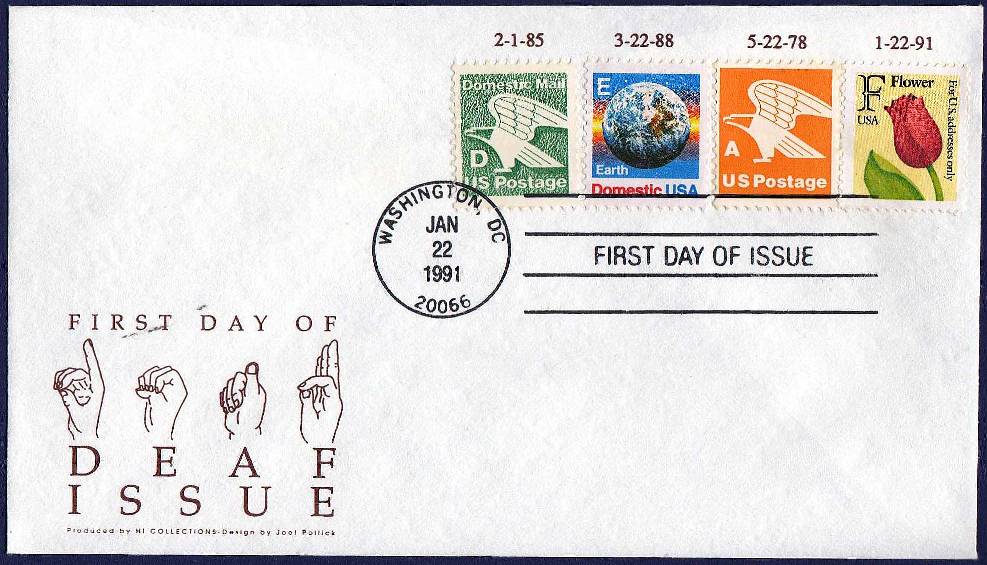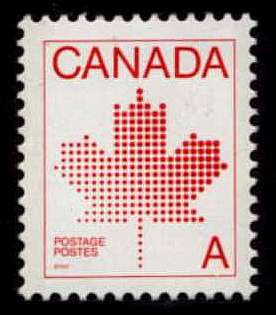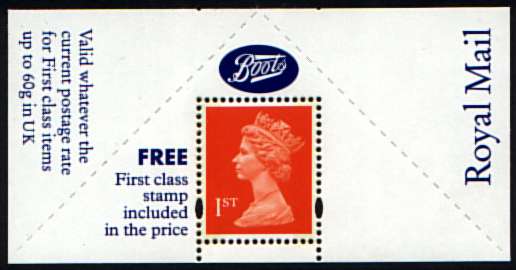

G is for G Stamp ... OR ALL the nondenominated stamps issued by the USPS |

|

|

|

|
CLICK HERE for an illustrated table of
ALL the non-denominated stamps the US has issued
The "G" stamp was the latest when this was first written in the series
of non-
denominated US alphabet stamps issued to aid the transition to new postal
rates in this
country - the USPS calls them "contingency stamps". None will win a design
competition,
but each has served its purpose well. We had A (1978) through H (1999). A
through D
were triumphs of ugliness,
with nothing but the letter and an eagle, while E, a slight improvement,
showed the
Earth, F was a Flower, G was the flag(Old Glory), and H was Uncle Sam's
Hat. Each paid the new first-class rate at the time it was issued
(scroll down for table). The
last three (F, G, H) were accompanied by Make-Up Rate stamps as well, to pay the
difference between the old rate and the new. The "F" Make-Up Rate stamp was
particularly atrocious, with its bizarre text-only design. (All are illustrated
below.)
With the rate increase of January, 2001, the USPS abandoned the alphabet, and
said it
did not plan to continue it. Too bad, I was looking forward to completing the
set, and
seeing what they did for some of the tougher letters. "X" is for Xylophone?
Xerxes?
X-rated?
Note also that, while most of these stamps were designated initially as valid
for
domestic use only
(and some are inscribed "Domestic" or "For U.S. addresses only"), the USPS
Domestic Mail
Manual states
explicitly that all nondenominated stamps are valid on international mail
except for those with special service inscriptions.
See: http://pe.usps.com/text/imm/immc1_005.html.
152.2.d. Nondenominated postage stamps (except for those that bear uniquely
domestic markings, such as First-Class Presort, Bulk Rate, Presorted Standard,
or Nonprofit Organization) may be affixed to postal
items that are sent to foreign countries. The value of such stamps is linked to
either a current or a former domestic rate (e.g., the "H" stamp has a postage
value of $0.33). Since the international
postage rates are always higher than the comparable domestic postage rates,
mailers who affix a single nondenominated postage stamp to their outbound
mailpieces must add additional postage to comply
with the international rate schedule. Note: The nondenominated Breast Cancer
Research semipostal stamp, which has a postage value that is equivalent to the
domestic rate for a 1-ounce letter, may be
used for international mailing purposes.
HOWEVER, many postal clerks are unaware of this ruling, and will tell you that
you CANNOT use non-denominated stamps on foreign mail, so unless you carry
along a copy of the DMM, and hand in your letters over the counter,
it is best to use them on domestic mail only.
To my surprise, this and its companion page
listing all the non-denominated U.S. stamps (see link, just below) have turnd
out to be the most popular
pages of my web site, with over twice as many hits as any other of the letter
pages. I
guess a lot of people have these non-denominated stamps lying around, and want
to know
what they are worth.
CLICK HERE for an illustrated table of
ALL the non-denominated stamps the US has issued
9/16/2007 -
Alain Vailly wrote to tell me about the NVI Club, which is headquartered in
France.
NVI stands for No Value Indicated. The Club's members collect stamps such as
the USA
rate-change stamps from countries all over the world. To learn more about the
NVI Club,
visit their website, at
http://pagesperso.lina.univ-nantes.fr/~vailly-
a/NVIClub/Apropos/gbindex.html.
Below is a table of the alphabet stamps and the associated rate changes since
the first
alphabet stamp was issued - note 1981, in particular - they raised the rates
twice in one
year! Yes, all of these are still valid as postage, at the rate shown below.
Click here for an illustrated table of
ALL the non-denominated stamps the US has issued
Click here
for
a history of USPS first-class rates since 1885 (Source = Postal Rate Commission.
Here are all the basic stamps in the rate-change alphabet to date, from A
through H,
with their values (each is still worth the value shown.)
Here's the text on the F makeup-rate stamp:
If you've never seen that F ATM sheetlet stamp before, don't worry - it was
part of the
first experiments with vending postage from ATM machines, and was available to
the
general public only from the ATMs of Seafirst Bank in the Seattle, Washington
area.
Collectors could buy it through the USPS Philatelic service, of course.
The USPS seemed determined to be prepared for every contingency with this
"contingency stamp" issue. They released seventeen different versions,
in six
different formats, with five different rates, from four different
manufacturers - there
were six different sheet stamps, six
coils, three
booklets, and two self-adhesives. I found it an entertaining challenge to
acquire them
all via postal channels, but many collectors were outraged at the seemingly
unnecessary
elaboration. Here they all are:
Interested in Flags On Stamps? Collector Bob Hunt has started a study
group for that topic -
email him at "bh1861(at)att.net" and tell him you want to join.
It's interesting to look at the FDC's that have been produced to mark the
issue of each
of the alphabet rate-change stamps. The initial reception was very simple and
respectful, but as they proliferated, the public's attitude changed to at best
tolerant
amusement, at worst open scorn.
Click on any image below to view an
enlargement.
But alas! They've ended the series (January, 2001) and while we will have
many more
rate changes, the rate-change alphabet is dead. (There's an amusing rumor
that the
alphabet was abandoned to avoid jokes about the i-rate stamp. I don't think
the postal
authorities really care that much what we think - the reason was probably more
mundane,
but it's unlikely we'll ever know what it was.)
P.S. - despite my lame attempts at satire above, I regard our postal rates
as a
great bargain. Compared to any other country today we are paying a very
reasonable
price, especially considering the size of the U. S. Rates in European
countries, where
the average distance a letter has to travel is much lower than here, are
significantly
higher.
8/29/07 - Ken Rothschild wrote me as follows:
I found your website fascinating....
I'd like to show what Albert Hlibok and I did when the USPS came out with the
"F" stamp.
Both Albert and I are Deaf and heavy into philately and this is what we
developed!!!
I'm sure you will get the gist when you look at the stamps. :-)
Below is the image he sent, which makes me even sadder that the USPS abandoned
their
alphabet. Think of all the fun we could have had spelling other things!
So your challenge now is to think of all the words you can spell with just
the letters A through H.
And congratulations to Ken and Al on a really
clever FDC!
How do other countries handle rate changes? Do they issue alphabet stamps?
Well,
Canada got as far as an "A" stamp - every bit as ugly as ours - back in 1981,
then
apparently decided they could plan ahead - no more since.
Great Britain issues non-denominated stamps that simply remain valid forever for
whatever class of postage is printed on them (e.g. 1st or 2nd).
Below is a booklet pane of "1st" stamps from a recent Christmas issue.
8/11/2004 - Oops! A viewer (
Ian Billings of Norvic Philatelics in the UK) writes:
The block of British stamps are not Christmas stamps - however inane Royal Mail
is at producing something appropriate for Christmas this isn't it. These are
general greetings stamps, often issued in the spring, in booklets, but now
re-branded as 'Occasions' stamps and issued in normal sheet format (and
Smilers). They are still 1st class and usually 5-6 in a set, sometimes se-
tenant.
Thanks for the correction. And it's nice to know the Brits regard their
stamps
(which many of us admire) with the same scorn we do our own.
And below is a favorite of mine, a "giveaway" promotion in Boots pharmacies,
the one-
stamp pane was "free" in a packet of greeting cards, and subsequently sold by
the British
Philatelic Bureau.
(there have been more than just the alphabet series).
(there have been more than just the alphabet series).
STAMP
VALUE
DATE of rate change
A
15 cents
5/29/78
B
18 cents
3/22/81
C
20 cents
11/1/81 (!)
D
22 cents
2/17/85
E
25 cents
4/3/88
F
29 cents
2/3/91
... F makeup rate
4 cents
G
32 cents
1/1/95
... G makeup rate
3 cents
H
33 cents
1/10/99
... H makeup rate
1 cent
(no I stamp)
34 cents
1/7/01
(there have been more than
just the alphabet series).
Our story so far - A postal alphabet
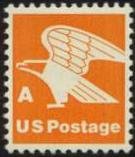
A = 15¢
1978
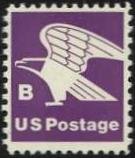
B = 18¢
1981
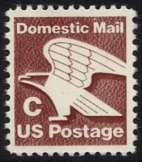
C = 20¢
1981
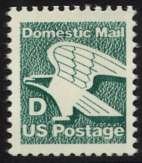
D = 22¢
1985
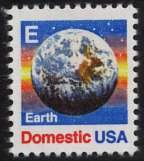
E = 25¢
1988
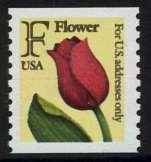
F = 29¢
1991
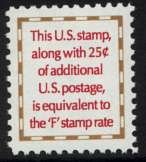
F makeup = 4¢
1991

F - ATM sheetlet = 29¢
1991

G = 32¢
1994

G makeup = 3¢
1994
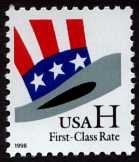
H = 33¢
1999
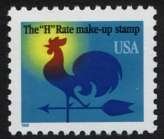
H makeup = 1¢
1999
This U.S. stamp, along with 25¢ of additional U.S.
postage, is
equivalent to the "F" stamp rate
A demented wannabe lawyer must have written that - how can a stamp,
with or
without additional postage, be equivalent to a rate?
Why so MANY G's!?



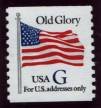

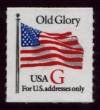
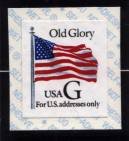






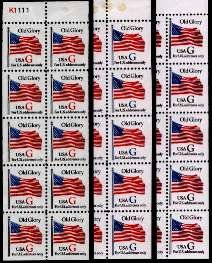
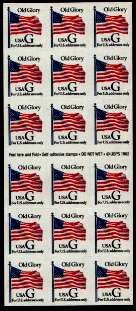
OR visit his web site
to learn more.
And don't miss
Flags on Stamps by Richard Mallett.
And how have they been received?
The "A" stamp - 15 cents - 1978
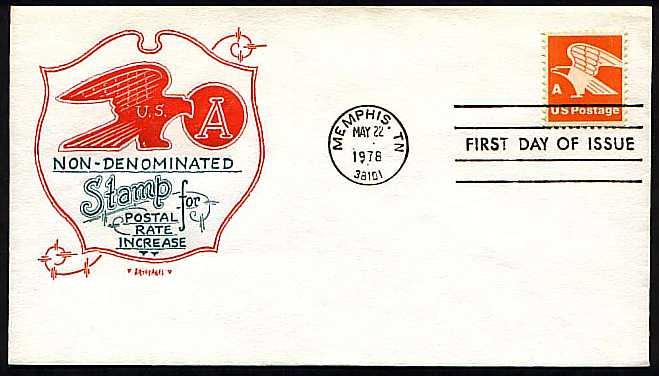
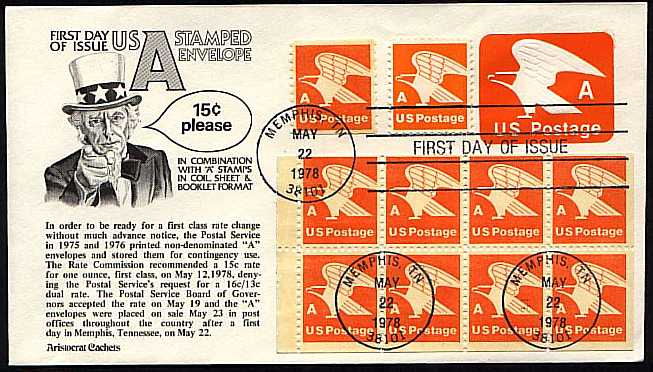
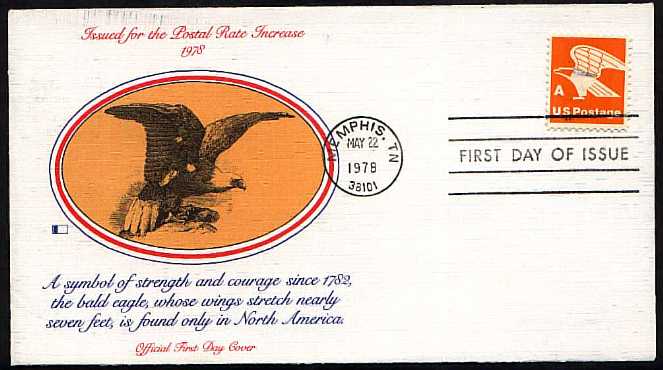
"Patriotic and dignified" would describe these "A" covers.
The "B" stamp - 18 cents - March, 1981
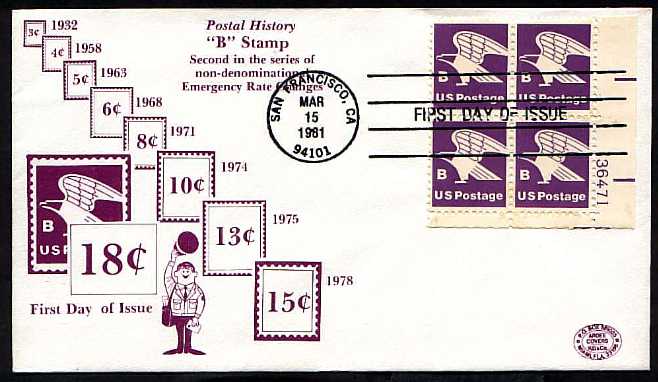
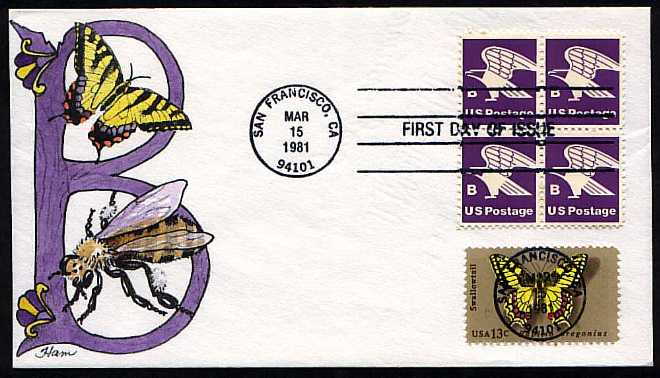
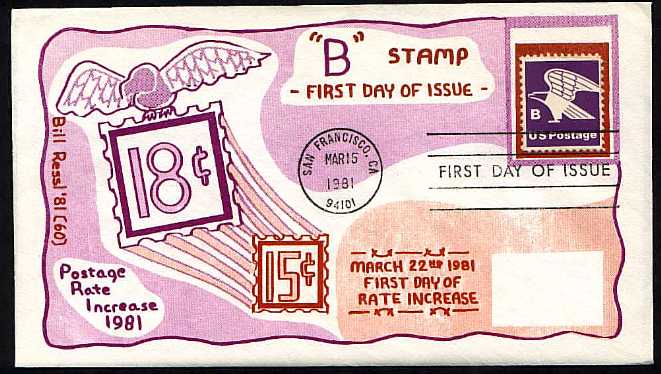
More fanciful, and beginning to place these rate changes in their historical
context,
but still no open disapproval here.
The "C" stamp - 20 cents - October, 1981
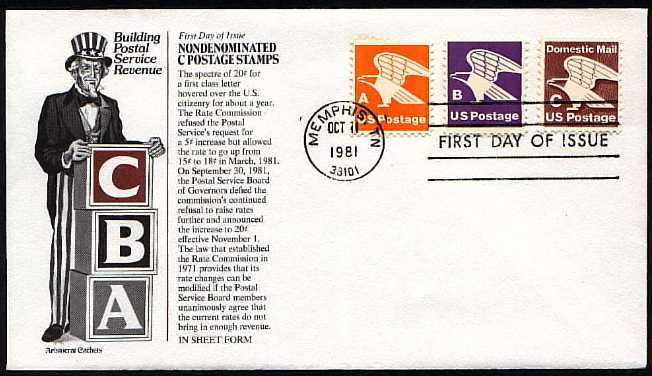
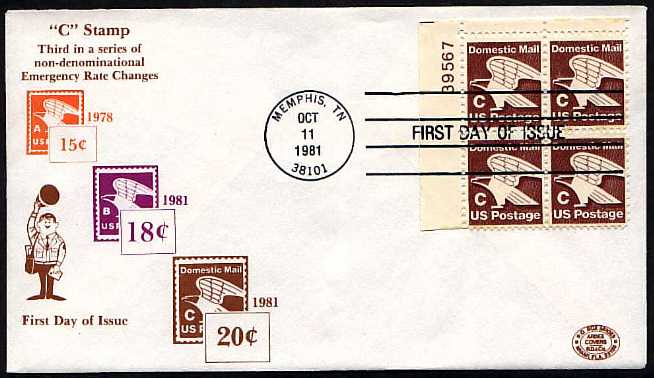
Surprising that these covers are not less mundane - this was the second
increase in a
single year, and brought the total increase for that year to 1/3, from 15 to
20 cents!
The "D" stamp - 22 cents - 1985
The "E" stamp - 25 cents - 1988
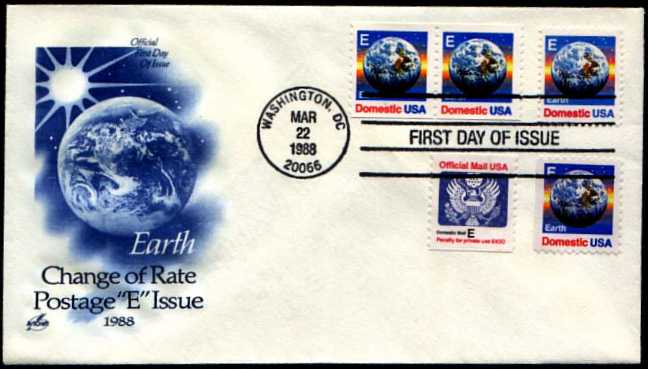
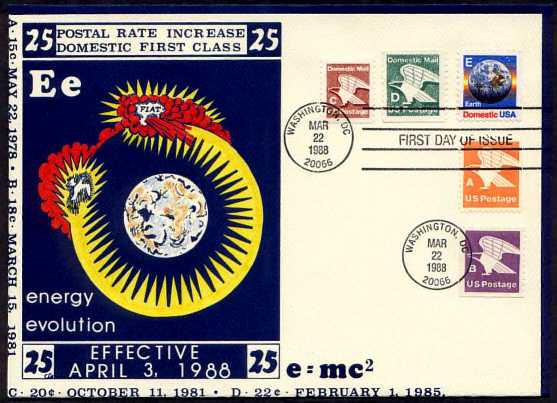
By now the public had grown accustomed to an increase every three years, and
this one
was relatively small, as a percentage of the prior rate. I wonder if that
Dodo cover had
anything to do with the decision to choose an image to represent the letter,
so that
people did not make up their own?
The "F" stamp - 29 cents - 1991
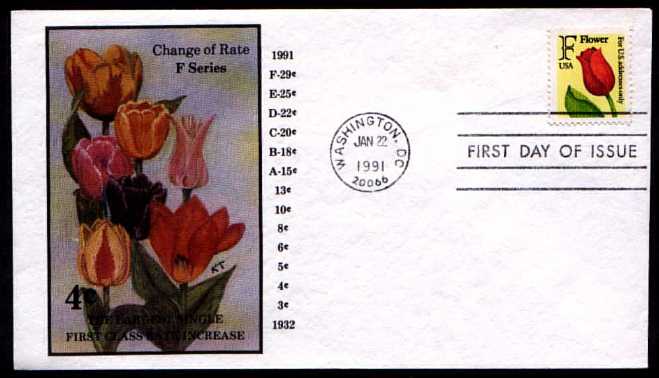
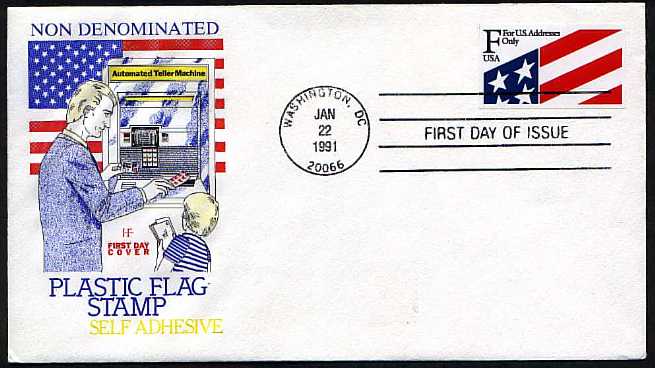
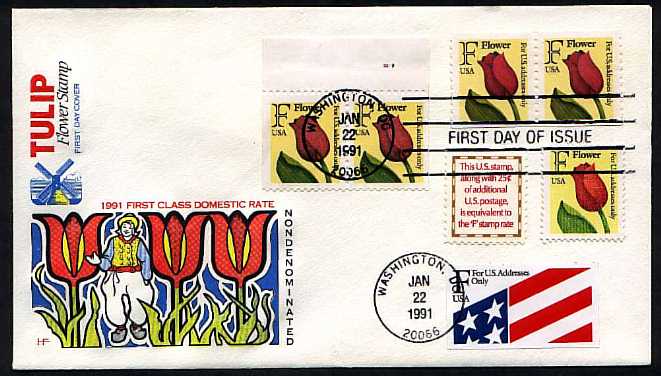
With the "F" stamp came the first of the makeup-rate stamps. Do you suppose
they made
it so ridiculous to distract us from the increase itself?
The "G" stamp - 32 cents - 1994
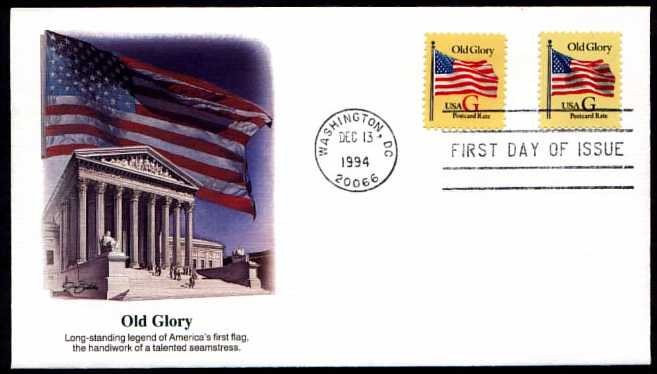
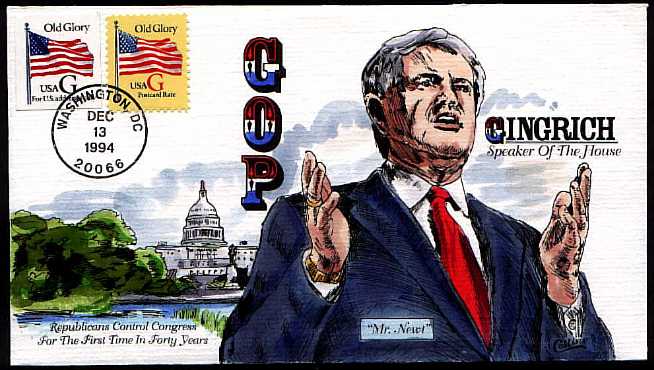
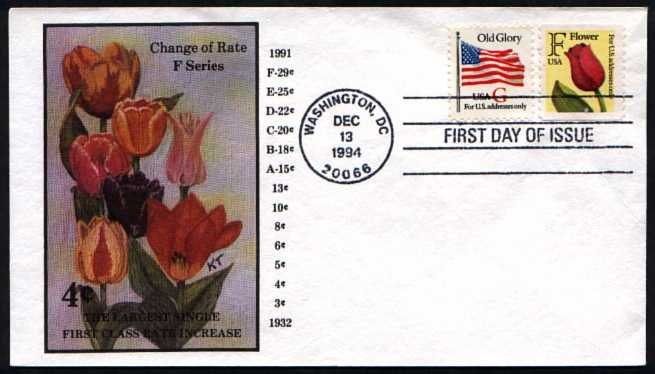
Apparently they couldn't think of a good "G" word, and had to fall back on Old
Glory,
obviously another effort to diffuse criticism with an appeal to patriotism.
Some cachet-
makers chose to ignore or reinterpret the designated theme.
The "H" stamp - 33 cents - 1999
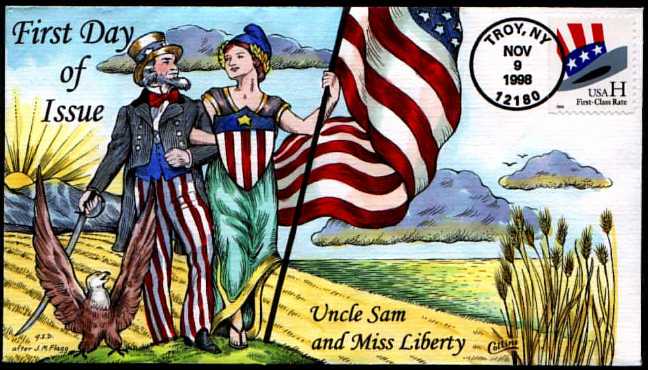
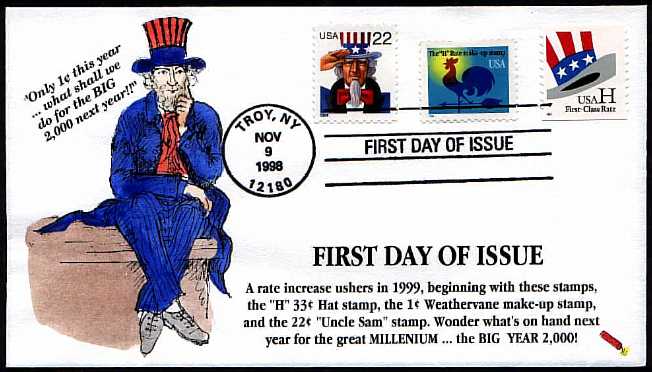
"H" is for "Hat", basically another flag, and more patriotism. I suspect this
will be
the theme from now on.
And what of "I"? The most patriotic "I" word I can think of is Independence.
There's
also "Inalienable". And "Inaugurate." But I would prefer Iguana or
Icthyosaur.
D - E - A - F
Rate change stamps in other countries
Those are the only ones I know about right now (June, 2000). I suspect most countries just delay implementing a new rate until they can print stamps with the correct denomination. If you know how other countries handle the situation, please email the webmaster at posterstampcc@gmail.com.
_____________________________________________________
3/12/2002 - a viewer sent the following information about French non- denominated stamps:
Take a look at the French situation. In my very ad-hoc collection I've got definitives with A, B, D on them. Back in the 1980s they had a Marianne in a liberty cap looking left. Both A and B were green (the latter postmarked 1987). Then they changed to a woman facing front, wearing what looks like a beret with a rosette in it. My D is on that and it's coloured red. Later they seem to have gone for colour coding for particular rates and not bothered to record what they are by letter or number. One of the red I have like this is postmarked 1993.
8/11/2004 - Ian Billings, in the message above about GB Greetings stamps, went on -
Of course non-denominated stamps have swept the globe since you wrote that page. I know somebody who has made a good collection - good enough to display at society nights and enter competitions. He starts with the 'Lady McLeod' (was that Trinidad?) back in the 19th century.
Some non-denoms, or NVI (No value indicated) have a letter, some state a postal service. S Africa, Guernsey & Singapore have wordy ones, for local use, and others for external. Brazil has an 'R' stamp, which is just that, a black R printed on a yellow & green background with a repeated micro-print of 'Brazilian PO' or whatever. This pays the Registration fee and I am pleased to have a couple of these on cover.
Thanks, Ian. Anybody else?
2/15/06 - I did a quick Google for "NVI stamps" and found that there is a
collectors' society for the
specialty, with an extensive web site at
http://www.sciences.univ-nantes.fr/asso/NVIClub/gbindex.php. It seems
that countries that have NOT issued non-denominated stamps are now the
exception.
Other non-denominated U.S. stamps
The alphabet stamps are not the only ones the USPS has issued without denominations - there have been nine other ordinary First Class rate stamps, one semi-postal, a host of special stamps for Bulk Rate and other high-volume uses, and four lettered Official stamps.
Click here for an illustrated table of ALL the non-denominated stamps the US has issued.
| Home | F is for Firsts <<< | Contents | >>> H is for Handstamp | Credits |
All Letter images Copyright © 1997, 2000, SF chapter of AIGA
All text Copyright © 2000, William M. Senkus
Send feedback to the webmaster: CLICK HERE
Created -- 06/18/2000
Revised -- 06/06/2016
